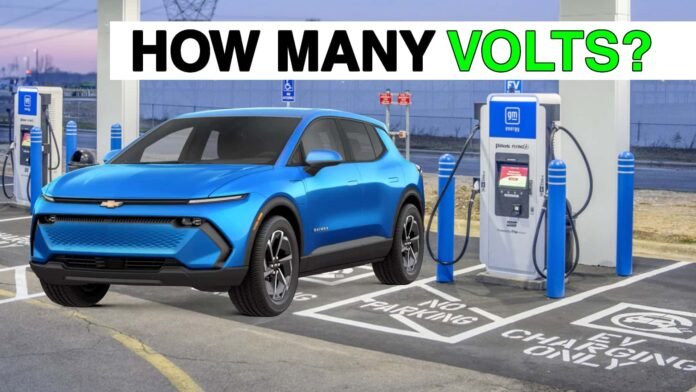






The Chevy Equinox EV is one of the most important new vehicles in General Motors’ lineup. Before the reborn Bolt EUV arrives next year, this crossover will be the cheapest electric vehicle the automaker sells—and one of the cheapest lithium-ion-powered EVs for sale right now, period. What’s special about the Equinox EV’s battery is how it shows off both the strengths and weaknesses of GM’s Ultium platform, especially with regard to the modules it produces now.
In short, it’s a monster for its range and price combo. But one tradeoff is voltage, and I’m about to dive into what that means for buyers.
| Vehicle | |
| Battery Chemistry | NMC (3.6V – 3.7V nominal) |
| Cell Form Factor | Pouch |
| Cell Capacity | 103Ah (~371Wh) |
| Total Module Count | 10 |
| Module Configuration | 8S 3P |
| Pack Configuration | 80S 3P |
| Nominal Pack Voltage (3.6V) | 288V |
| Calculated Pack Capacity (total at nominal voltage) | 89.0 kWh |
| Reported Usable Capacity | 85 kWh |
The Equinox EV battery module is the same one found in every Ultium-based EV produced to date. Its nominal voltage sits at around 28.8V, which is important. Even in larger pack Ultium cars like the 12-module Cadillac Lyriq, all of these groups of cells are wired in series, meaning the pack voltage out of the terminals is entirely dependent on how many modules are present.
This means the Equinox EV’s 85 kWh pack had to lose voltage to achieve the lower capacity necessary to bring down the vehicle price. It has just 10 modules, mounted in the floor of the vehicle. This gives the car an 80S pack, meaning a nominal voltage of 288V. So, the Equinox does not really have a 400V architecture; it’s more like a 300V system. (As an interesting side note, the Corvette E-Ray’s hybrid battery is also 288V nominal, although not much of that pack’s true capacity is being used.)
The Corvette E-Ray’s 80S pack, nestled into the vehicle’s structural center tunnel.
But what does this mean in the grand scheme of things? Well, the Equinox EV can’t charge as fast as the larger Blazer EV with its 102 kWh battery or the Lyriq; the Equinox EV maxes out at 150kW compared to those cars’ 190kW. Higher voltages tend to mean faster charge speeds, and losing voltage means a slower charge unless the amperage, the other component of power along with voltage, is brought up to compensate, which isn’t possible here.
Charging is all about voltage and current. Wattage is just the two figures multiplied. A car that can charge at 50kW—50,000 watts—has some combination of voltage and current to achieve that figure.
Forgive the technical explanation below, but trust me when I say this will all make sense soon.
Individual battery cells have a charged, nominal, and discharged voltage. For lithium-ion Nickel Manganese Cobalt (NMC) cells, it’s around 4.2V charged, 3.6V nominal, and 2.8V discharged. You can take these cell limits slightly higher or lower, but it usually shortens the cell’s life. Some automakers charge their battery cells all the way up to 4.25V to chase that little bit of extra range, for instance. The new electric Dodge Charger does this (if its spec sheet is accurate.) GM does not do this.
To charge a battery cell, you apply its charged voltage across the terminals at a certain current. If you want it to charge faster, you apply more current, but the voltage remains the same. Cells have ratings that tell you how much current can be applied to them for how long. If you exceed these limits, you enter the danger zone. Cycle life can be reduced, cells may passively discharge much faster than usual, and more visible trouble like expansion, smoking, or fire is possible. The latter is uncommon without extreme abuse.
Battery pack voltage is determined by how the cells are wired up internally. The Equinox has three parallel groups of 80 cells in series. This translates into the car’s 288V nominal pack voltage (3.6V multiplied by 80). If we wanted to charge it completely, we would apply 336V (4.2V multiplied by 80) across the pack’s terminals. Again, GM does not do this; it charges the car to a lower voltage to enhance cell longevity.
If we apply more current the car can theoretically charge faster, but we run into the aforementioned cell ratings. More current means more heat which must be dissipated, and at a certain point the cells, pack cooling system, or both can’t handle it.
So GM knows its charging voltage for the Equinox EV’s pack and how much current the cells can take in a continuous charge. Say, for the sake of argument, that GM did charge the pack at 336V. If we put a measly five amps into the pack, it would charge at 1,680W (336V multiplied by 5). If we instead put 400 amps into the system at this voltage, we would get 134,400W (134.4 kilowatts). That’s how charge rates work.
The Equinox pack’s three parallel groups boost the amount of current that can be absorbed, but the car’s low voltage fundamentally limits the power that the pack can take in. You might understand now why high-voltage architectures can charge much faster. If we increase the voltage we don’t get nearly as large of an increase in heat under charging and the math tells us our wattage is now much higher if the current stays the same. More kilowatts.
The basic Ultium battery module which underpins every GM electric vehicle today, except the Cadillac Celestiq
This is why cars with 800V-nominal packs can typically charge at closer to 350kW. Many Hyundai and Kia products, the Lucid Air, and the Tesla Cybertruck, operate natively at around 800V. The GMC Hummer EV operates its drive units at around 350V but can charge at around 800V by wiring the two halves of its massive pack in series; this is called a “split pack setup.”
Lower voltage also theoretically translates into less top-end performance, but this is a little more complicated. You can design a permanent magnet motor’s windings so that it spins at a certain speed for a given voltage. This is known as the motor’s kV rating. kV is simply motor RPM per volt of input. A 100kV motor will spin at 100 rpm when a single volt is applied to it, 500 RPM at 5V, etc. Electric drive units have a reduction gear to achieve wheel speeds so you can tailor the entire system—motor, reduction, voltage—to achieve the specific compromise you want.
Electric motor stators from GM’s Ultium drive units
If you think the vehicle will spend most of its time at high speeds, you may want a lower gear ratio in order to have power up top before the motor runs out of steam. This will cost you torque, though, which can only be made up by adding amperage, which is a whole can of worms.
The compromise was clearly made for a lower range of operating speeds in the Equinox EV. Its front drive unit has an 11.59:1 ratio as compared to the RWD Lyriq/Blazer’s 11.63:1 (almost identical). If the motor KV rating is similar—which I unfortunately can only assume—the top-end performance will suffer.
In practice, this isn’t much of an assumption. Driving the FWD Equinox EV, we noticed that above 75 mph it gets seriously short on power. This phenomenon is a combination of all of these factors.
On the flip side of this, we can look at the AWD Cadillac Lyriq. Its front and rear drive units have ratios of 9.87:1 and 10.49:1, respectively. The Lyriq’s pack has a higher voltage and two drive units, so the current handling capability of the drivetrain is increased. This means more torque, higher potential speed, and greater power.
All of this leads to an interesting conundrum. GM will very likely be producing vehicles with lithium-ion NMC packs smaller than the Equinox—85 kWh is awfully big for an automaker’s smallest battery—but if you remove more modules the voltage becomes very low. A 53kWh pack using six standard Ultium modules translates into just ~172.8V nominal. That’s only acceptable for something like a city car; indeed, many small Chinese EVs operate in this range or even lower. (The standard Nissan Leaf has only a 40 kWh battery, for example.)
The only way around this problem is to make a new module or rewire the existing one. From the outside, it may seem like GM has backed itself into a corner here.
The layout of the basic Ultium module could solve this problem, though. Its configuration is 8S 3P for 24 cells total, a pleasantly divisible number. It could be rewired to a 12S 2P configuration which offers higher voltage per module. I’ve seen a chart laying out how GM may plan to do this, but I’m not sure how official it is anymore.
The chart in question
With a hypothetical 12S module (roughly 43.2 volts nominal), a 53kWh pack with this new 72S configuration is not 172.8V, but 259.2V, which is in the range of existing architectures.
I presented the aforementioned chart to one of GM’s representatives, but I was told this information was “outdated.” Car companies also dislike speculating on future products they haven’t formally announced. As such, I was told that, at least right now, “there aren’t any smaller or larger modules.”
Getting more information on this front will probably be tough because clarifying the existence of a higher-voltage Ultium module effectively announces that smaller EVs are in development, which we do not know of beyond the updated Bolt EUV.
So the Equinox EV tells us a lot about GM’s electric strategy and how it plans to navigate various sizes and classes of vehicles. The automaker decided to commercialize its larger EVs first and the modules that power them.
The Equinox is the smallest EV to use these lower-voltage modules, which means it was the company’s first small-ish Ultium EV to be released. Going even smaller means changing the module via rewiring.
In the case of the upcoming Ultium Bolt EUV, this will mean switching chemistries to lithium-iron-phosphate (LFP) for greater cost savings. How the automaker plans to do this is yet to be seen. It will likely need a new battery cell and module. The automaker refused to clarify those details at this time.
Producing both in volume right off the bat will be difficult, and with the Bolt EUV’s reveal date set for next year, the company is doubtlessly rushing to get all of the pieces in place.
[Correction 6/11/24 at 5:14 p.m.: This article originally stated that two of the vehicle’s 10 battery modules are mounted under the hood. That is incorrect, the entire battery pack is structurally integrated into the floor of the vehicle. We regret the error.]

Source link
#Chevy #Equinox #Tells #Lot #Voltage #Matters








